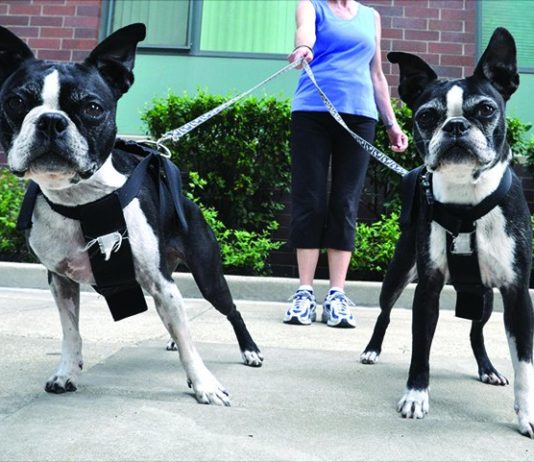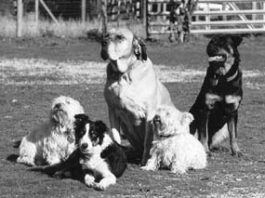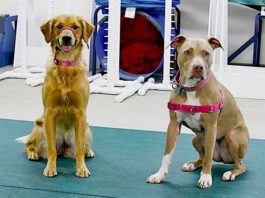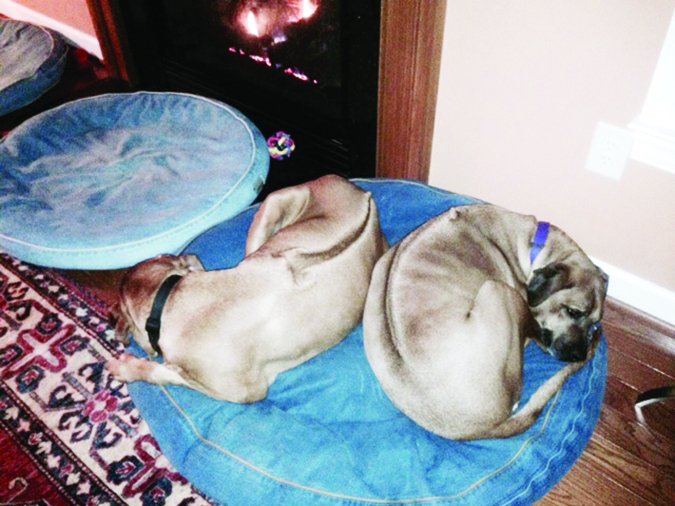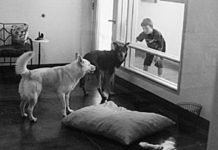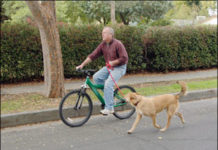Enjoying Your New Dog as The Seasons Turn to Spring
Spring is here and so is shedding season! Suddenly, every carpet in the house is woven with dog hair. Otto has what can be best described as a “combination coat” (I just made that up). Much of his outer coat is made up of long, stiff, straight hair – resembling that from a German Shepherd, or maybe a Labrador – that seems to wriggle into the carpet pattern itself. My vacuum is helpless in the face of this hair. Admittedly, it’s not a great vacuum, so cleaning the few carpets we have has turned into aerobic exercise. Quite some time ago, Black & Decker sent me a new DustBuster (handheld power vacuum) to try. This one is the “Retriever Pet Series Cyclonic Action,” and it plugs in; it’s powerful, unlike wimpy cordless models I’ve owned in my past. Used with its “turbo brush” (spinning rubber bristles) attachment, it’s fantastic at getting pet hair off our couch. But with an approximately three-inch intake, it’s not useful for cleaning entire carpets. My sister Pam has been telling me I absolutely have to get the same vacuum she recently bought: A Dyson “Animal.” She has three small white dogs and swears that she had enough hair to make another, larger dog out of the stuff that the new vacuum cleaned up on its inaugural tour through her house. “I had forgotten what a dark color my couches actually were!” she reported, incredulous. “And my rugs are beautiful!”
Tips on Adopting a Senior Dog
When my husband asked me to come to the shelter where he worked to meet the 8-year-old Australian Shepherd he had fallen in love with and wanted to adopt, of course I said yes. When Paul first met Missy, she threw herself on her back at his feet, and he was hooked. When I saw her striking red merle coat, her stunning odd eyes" (one brown
Selecting Your Next Dog or Puppy
Thinking of getting a new dog? Chances are you're inundated with well-intentioned advice from every friend, family member, and canine professional you know about where to go and who to avoid in your quest to find your next canine pal. You may also feel the added burden of finding the right dog - one who will be as close to perfect as caninely possible. It's an awesome challenge. Many years ago, I was living on my own for the first time, and missed having a dog in my life. I went on a Collie search, and soon answered an ad in the paper for Marty's Pride, a tri-color Rough Collie whose owner had gone off to college. Marty was near canine-perfect: the first dog I showed in AKC obedience competition (he earned his Companion Dog title in three trials with scores of 194.5, 196, and 197), and the first dog I ever owned who died of old age. He was also the last dog I deliberately went looking to adopt. Since then my selections have been much more serendipitous. My husband and I tend to adopt the dogs who find us, or we trip over them at the shelter and bring them home. I realize that we're the exception, not the rule. Most people make more deliberate decisions than we do about the kind of dog they want, and where to find him - or her. Those decisions, although deliberate, are not always wise. I'm constantly amazed by the number of clients in my behavior consultation practice who thought they were making well-educated, well-researched decisions about the acquisition of their new four-legged family member, and ended up with something vastly different from what they expected. So how do you make an educated, responsible decision about selecting your next dog?
How to Help a Shelter Dog Find a Home
Many animal lovers in this country are aware of an epidemic that’s affecting our companion dogs and cats. There’s no easy cure; at best we can apply palliative measures. The epidemic? Rampant homelessness. According to the Humane Society of the United States, 6 to 8 million dogs and cats enter shelters each year – and fully half of them are euthanized because they run out of time or are not considered adoptable.
The Rewards of Adopting an Older Dog
The nine-year-old Golden Retriever was a mess. Her nails were so long, they curved around and made walking difficult, her coat was filthy, and her ears were so badly infected that her veterinarian recommended surgery. Now she was being given up for adoption. Would anyone want her? The odds were against it, but herefs a holistic makeover story in which an old dog gets a new name, a new look, a new home, and an exciting new life. It also serves as a model for an ideal adoption and rehabilitation of an older dog.
Training Your Newly Adopted Dog
I have had a number of dogs over the years, but Otto is actually the very first dog that I’ve gotten as a co-owner. A former boyfriend paid the $40 or $50 that a Bodega, California, sheep rancher wanted for my heart/soul dog, Rupert, way back in 1989, but the puppy was a birthday present for me; Rupe was always my dog. He stuck close by my side through the breakup of that relationship and the next few, too. When Brian (the man who later became my husband) came on the scene, he and Rupert formed a bond, but still, Rupe was mine. Later, a summer of dog-sitting my sister Sue’s long-haired Chihuahua, Mokie, turned into a several-year stay. Mokie has since gone on to live with my sister Pam, who won’t ever give him up; Brian was more than happy when I did so. He tolerated Mokie, but never fully embraced the idea of a yappy little house-dog, no matter how smart and cute. So, while Brian and I have shared a home since 1996, we have never truly shared full ownership of a dog, like we do now. I selected Otto from a shelter, but Brian was the one who gave the signal that it was time for us to get a dog. When Brian and I got married, I kept my own last name, but Brian wanted to be sure that Otto took his surname, and even made sure the dog’s full name (“Otto Maddock”) was engraved on his ID tag. And Brian has been a real champ about sharing dog-care duties with me.
Adoptee Arrives With Baggage
establishing safe spots for them on either side of the bed; they were compelled to stay on their own cozy beds with a six-foot leash fastened to an eyebolt in the wall.
Dr. Bain also suggested that we use muzzles on both Jasmine and Sassy when they were together. She recommended basket-type muzzles
Tips on Adding a Dog to Your Household
We currently have three dogs. We lost our Scottie a few months ago to cancer, and our Australian Shepherd last year to old age and failing health. This is the fewest number of dogs we've had in our family for as far back as I care to remember, and while I grieve Missy and Dubhy's absence every day, a part of me feels some guilty relief that the canine chaos and caretaking load has lightened somewhat. Still, while I know it won't be for a while yet, another part of me contemplates the next potential pup-addition to the Miller pack . . . which leads me to contemplate the complexities and challenges of bringing home a new dog.
Acquiring a New Dog or Puppy
So, we have a new dog! I’m soooo happy! And while it’s been really time-consuming to properly integrate a new dog into our household, it’s also been incredibly rewarding, interesting . . . and inspiring! Inspiring to have a fresh opportunity to experience many of the things we talk about in WDJ – with a sense of urgency and immediacy I haven’t had for quite some time! Just in our first few days I was thinking hard about things like potty training, how to deal with dogs who are not food-motivated, finding a good vet, vaccination, parasite control (fleas, ticks, heartworm), introducing dogs to cats, barking, leash manners, the best food, itchy skin, digging (as you’ll see on page 18), no-slip collars, dogs who are uncomfortable indoors, quiet clickers, and much more.
Bonding With Your Adopted Dog
As a trainer, I am hyperaware of the dynamics between dogs and their owners. I have watched countless human-canine teams in group classes blossom together in beautiful demonstrations of communication and cooperation. Unfortunately, I have also seen people struggle. Teaching a dog a new skill can be difficult for any owner, especially if the person has never practiced it before. A good coach can help solve the sticking points in training . . . but more troublesome is when an owner's bond with a dog seems very weak, or non-existent.
Ways to Help Your Local Animal Shelter
By volunteering at an animal shelter, you can directly increase the number of dogs that win" the contest of their lives. Shelters are almost always under-funded
Too Mean To Keep?
I have a serious problem with my six-year-old neutered male Vizsla. He was a high strung, but good tempered dog for the first three years of his life. Something seemed to snap after that. He is loving and affectionate most of the time, but he gets aggressive when family members leave the kitchen (he and our other dog are limited to the kitchen and family room). He barks, snaps at them, and snags clothes with his teeth. He has never chomped down and bitten anyone, but he has scratched people with a tooth.


